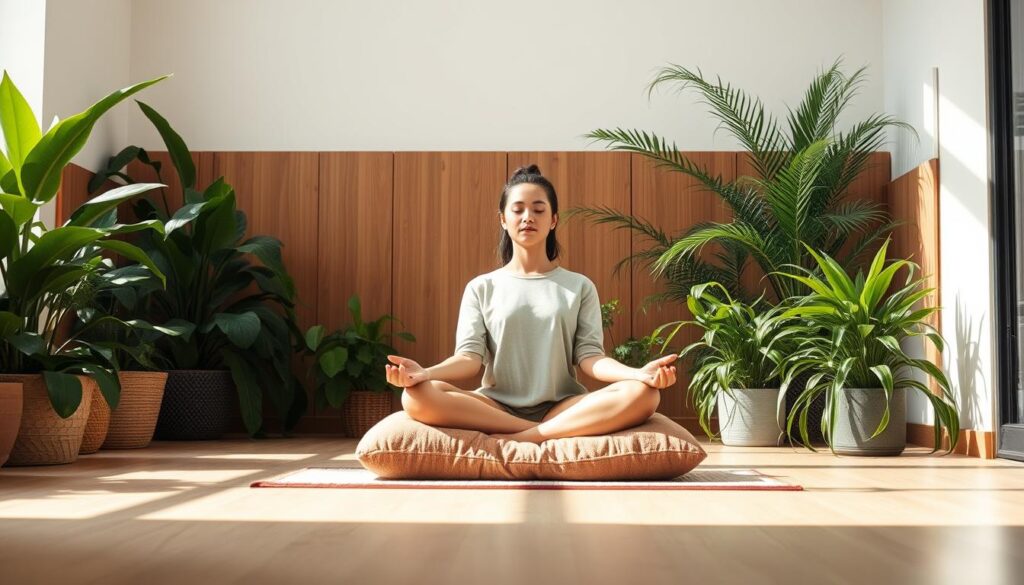I’ve struggled with anxiety for years, and discovering meditation was a game-changer for my mental health. It was like finding a quiet room in a noisy house – a refuge from the constant worry and stress.
In my journey, I’ve found that meditation isn’t just a practice; it’s a tool that has helped me understand and manage my anxiety. By incorporating various techniques, such as mindfulness meditation, I’ve been able to reduce my stress levels and improve my overall well-being.
Research supports my experience, showing that meditation can significantly reduce anxiety symptoms by affecting stress hormones and nervous system responses. Whether you’re dealing with occasional worry or chronic anxiety, meditation offers a practical approach to achieving calm.
Key Takeaways
- Discover how meditation can help alleviate anxiety symptoms.
- Learn effective meditation techniques for stress relief.
- Understand the science behind meditation’s impact on anxiety.
- Explore the benefits of mindfulness meditation for overall well-being.
- Start your journey to a calmer, more centered you.
Understanding Anxiety and How Meditation Can Help
Anxiety can be overwhelming, but understanding its impact on our body and mind is the first step towards managing it. When we comprehend how anxiety affects us, we can better appreciate the role that meditation plays in alleviating its symptoms.
Anxiety triggers a cascade of reactions in our body, preparing it for the “fight or flight” response. This natural response is meant to be temporary, but chronic anxiety can keep our bodies on high alert, leading to various physical and mental health issues.
The Physical and Mental Impact of Anxiety
Anxiety affects both our physical and mental well-being. Physically, it can manifest as rapid heartbeat, sweating, and trembling. Mentally, it can lead to feelings of dread, panic, and an inability to focus. Chronic anxiety can have long-term effects on our body, including increased stress hormone levels, such as cortisol.
How Meditation Counteracts Anxiety Responses
Meditation practice has been shown to counteract the effects of anxiety by activating the parasympathetic nervous system, promoting relaxation and reducing stress hormones. Regular meditation helps in managing anxiety by:
- Activating the “rest and digest” mode, counterbalancing the anxiety response.
- Training the brain to return to a calm state more quickly.
- Creating a buffer zone between triggers and reactions.
- Lowering heart rate and blood pressure through breathing techniques.
- Helping to observe anxious thoughts without becoming them.
Research from the University of California, Davis, supports the idea that generalized meditation programs can lead to lower levels of cortisol, a key stress hormone. By incorporating meditation into our daily routine, we can develop a more resilient response to anxiety.
| Benefits of Meditation | Impact on Anxiety |
|---|---|
| Activates parasympathetic nervous system | Reduces stress hormones |
| Enhances mental clarity and focus | Decreases feelings of overwhelm |
| Promotes relaxation and calmness | Lowers anxiety levels |
For more information on the benefits of meditation, you can visit Mayo Clinic’s meditation page.
The Science-Backed Benefits of Meditation
As it turns out, meditation is not just a trendy practice, but a powerful tool backed by research. When we examine the science behind meditation, we can see that it has a significant impact on our mental and physical well-being.

Neurological Changes
Research from the University of California, Davis, has shown that meditation can alter our genes, dampening those involved in the inflammatory response and promoting those associated with DNA stability. This can lead to improvements in attention and clarity of thinking, helping to keep our minds sharp as we age.
Stress Hormone Reduction
Studies have found that regular meditation can bring about changes in our brain, including an increase in the thickness of our prefrontal cortex. This part of our brain is responsible for rational thinking and decision-making, which can often go offline during anxiety attacks. By strengthening this area, we can better manage stress and anxiety.
Long-Term Brain Structure Improvements
Long-term meditators have been found to have more folding in the cerebral cortex, which is associated with faster information processing and better attention. Moreover, meditation strengthens the connection between our prefrontal cortex and amydala, improving our emotional regulation when faced with stressors. As a result, we can experience a lasting rewiring of our brain’s architecture, leading to continued growth of benefits over time.
Mindfulness Meditation for Anxiety Relief
Practicing mindfulness meditation can be a game-changer for those struggling with anxiety.
As we dive into the world of mindfulness, let’s explore what makes it so effective for anxiety relief and some simple techniques to get you started.

What Makes Mindfulness Effective for Anxiety
Mindfulness meditation is effective for anxiety because it helps you focus on the present moment, reducing worries about the past or future. By concentrating on your breathing or bodily sensations, you can achieve a state of calm and reduce anxiety.
As you practice mindfulness, you’ll become more aware of your thoughts and emotions, allowing you to manage them more effectively.
Simple Mindfulness Techniques for Beginners
For those new to mindfulness, starting with short minutes-long sessions can be beneficial. Begin by sitting comfortably, focusing on your breathing, and gently returning your attention whenever your mind wanders.
Some useful techniques include the 5-5-5 method (breathing in for 5 counts, holding for 5, exhaling for 5), the STOP technique (Stop, Take a breath, Observe, Proceed), and body scan meditation.
As you establish a regular meditation practice, you’ll find that these techniques become more accessible, helping you manage anxiety more effectively.
Focused-Attention Meditation Techniques

Meditation techniques that emphasize focused attention can significantly alleviate anxiety symptoms. By concentrating your mind, you can reduce the mental chatter that often accompanies anxiety.
Breath-Focused Meditation
Breath-focused meditation is a simple yet effective technique. It involves concentrating on your breath, observing its pattern, and letting go of distracting thoughts. This practice helps calm the mind and reduce anxiety.
Mantra Meditation for Anxiety
Mantra meditation uses a repeated word or phrase as a focal point. Techniques like Kirtan Kriya, which combines a mantra with repetitive finger motions, can be particularly helpful. You can use traditional Sanskrit mantras or simple phrases like “I am safe” to counter anxiety thoughts.
The repetitive nature of mantra meditation has a calming effect on the nervous system. Synchronizing your mantra with your breath can enhance this effect, creating a powerful mind-body connection.
Loving-Kindness Meditation to Combat Anxiety

Loving-kindness meditation is a powerful tool to combat anxiety. This type of meditation, also known as Metta meditation, begins with developing kind thoughts and feelings toward yourself. As you practice, you will learn to extend this kindness and forgiveness to others, starting with friends, then acquaintances, and ultimately those you may consider enemies.
How Self-Compassion Reduces Anxiety
Self-compassion plays a crucial role in reducing anxiety. When you cultivate kindness toward yourself, you reduce self-criticism and increase feelings of safety and well-being. This, in turn, helps to reduce anxiety and promote a sense of calm.
Step-by-Step Loving-Kindness Practice
To practice loving-kindness meditation, start by getting comfortable and bringing to mind someone who evokes feelings of love, such as a child or supportive friend. Repeat simple phrases like “May I be safe, may I be healthy, may I be happy, may I live with ease,” focusing on the genuine wish for your own well-being. As you get more comfortable with the practice, you can extend these wishes to others, widening your circle of compassion.
Body Scan Meditation for Physical Anxiety Symptoms
As we navigate through anxious moments, our body can become a battleground of tension.

Releasing Physical Tension Through Awareness
Body scan meditation helps us release physical tension by bringing awareness to our body.
We start by finding a comfortable position, either lying down or sitting, where we can stay for 10-15 minutes without being disturbed.
Guided Body Scan Practice
To practice body scan meditation, begin by taking a few deep breaths to center yourself, then bring your attention to your feet, noticing any sensations present without trying to change them.
Slowly move your attention upward through your body – through your ankles, calves, knees, and thighs – spending about 20-30 seconds with each area before moving on.
Creating a Sustainable Meditation Practice
To truly benefit from meditation, it’s essential to make it a sustainable part of your daily routine. Consistency is key to experiencing the long-term benefits of meditation, especially when it comes to managing anxiety.
Starting small is a great way to begin. 5-minute meditation sessions can be a gentle introduction to the practice, making it feel less daunting and more achievable, even for the busiest individuals.
Starting Small: 5-Minute Meditation Sessions
Begin with short, manageable sessions. Research has shown that even brief periods of meditation can have a positive impact on stress levels. For instance, a study found that people who used a meditation app for just 10 days experienced a 12% decrease in stress levels.
Finding the Right Time and Space
Identifying a consistent time and quiet space for meditation is crucial. It could be early in the morning, during your lunch break, or right before bed – whatever works best for your schedule and preferences.
Using Technology to Support Your Practice
Meditation apps have made it easier to stick to a practice. They offer guided sessions that remove the uncertainty of “am I doing this right?” and provide structure. For example, timer apps with gentle bells can help maintain session structure without jarring interruptions. Additionally, scheduling reminders on your phone can support your practice by leveraging your existing habit of checking your phone regularly.

Overcoming Common Meditation Challenges
As we embark on the journey of meditation, we might encounter a few roadblocks that can stop us from reaching our full potential. Meditation is something everyone can do to improve their mental and emotional health without special equipment or costly memberships. Trying out a style of meditation suited to our goals is a great way to improve our quality of life, even if we only have a few minutes to do it daily.
When it comes to meditation, some challenges are more common than others. Let’s look into some of these challenges and how we can overcome them.
“I Can’t Stop Thinking” – Working with a Busy Mind
One of the most common challenges people face is dealing with a busy mind. We often expect our minds to be calm during meditation, but the reality is that our minds can be quite active. The key is not to stop our thoughts completely but to learn how to manage them.
As I have experienced, expecting immediate results from meditation is like expecting six-pack abs after one gym session – it doesn’t work that way. Neurological changes happen gradually with consistent practice. The paradox of meditation is that attachment to results actually hinders progress – the moment I stopped trying to “achieve” meditation and simply showed up, my practice deepened.
- Progress isn’t linear – some days our mind will be relatively calm, other days it’ll be a flurry of thoughts, and that’s completely normal.
- If we’re feeling impatient, we can try setting concrete mini-goals like “we’ll practice for 10 days straight” rather than vague outcomes like “we want to feel less anxious.”
Dealing with Impatience and Expectations
Dealing with impatience is another hurdle. We live in a world where we are used to getting results quickly, but meditation is a practice that requires patience and persistence. We have to remind ourselves that even experienced meditators have challenging sessions – the skill isn’t in having a perfectly calm mind but in how we relate to whatever mind shows up that day.
“If you don’t change your life, you will never have a good life” –
Let’s look at some common challenges and some simple ways to overcome them in the table below:
| Challenge | Solution |
|---|---|
| Busy mind | Manage thoughts, don’t try to stop them |
| Impatience | Set concrete mini-goals |
| Unrealistic expectations | Understand that progress is not linear |
As we continue our meditation journey, we will find that it is not about achieving a specific state but about being present with what we experience in the present moment. With time and consistent practice, we can overcome the common challenges and reap the benefits of meditation.
We can start with simple steps like dedicating a few minutes each day to meditation, being consistent, and being kind to ourselves as we navigate through our thoughts and emotions.
Integrating Meditation into Your Daily Anxiety Management
As we explore ways to manage anxiety, integrating meditation into your daily routine can be a game-changer. By combining meditation with other strategies, you can enhance its benefits and develop a more robust approach to managing anxiety.
Combining Meditation with Other Anxiety-Reduction Strategies
To maximize the effectiveness of meditation, it’s helpful to combine it with other anxiety-reduction techniques. For instance, breathing exercises can be seamlessly integrated into your meditation practice. Techniques like the 4-7-8 breathing method – inhaling for 4 counts, holding for 7, and exhaling for 8 – can quickly activate your parasympathetic nervous system, providing immediate relief from acute anxiety.
Another technique is the “5-4-3-2-1” grounding exercise, which, while not technically meditation, uses similar mindful awareness to help calm the mind. This exercise involves naming 5 things you see, 4 things you feel, 3 things you hear, 2 things you smell, and 1 thing you taste, effectively grounding you in the present moment.
Mini-Meditations for Acute Anxiety Moments
For those moments when anxiety spikes, mini-meditations can be incredibly useful. Even 30 seconds of conscious breathing can interrupt an anxiety spiral. Techniques like hand-on-heart meditation, where you place your hand on your heart, breathe deeply, and mentally repeat “I am safe right now,” can provide immediate nervous system regulation.
These brief practices work by interrupting the default anxiety response and creating a moment of choice, allowing you to reset your stress response. By incorporating these mini-meditations into your daily routine, you can better manage stress and reduce anxiety.
Conclusion: Embracing Meditation as a Path to Calm
By incorporating meditation into daily life, individuals can experience profound positive change. This practice offers a sustainable solution for managing anxiety. The benefits of meditation extend far beyond anxiety relief, enhancing overall health and well-being.
Start with what you have, even just a few minutes a day, and be patient with yourself as you begin this journey.
FAQ
What is the connection between meditation and anxiety relief?
Meditation has been found to reduce anxiety by promoting relaxation, reducing stress hormones like cortisol, and enhancing the brain’s ability to handle stress.
How does mindfulness meditation help with anxiety?
Mindfulness meditation helps by making you more aware of your thoughts and feelings, allowing you to observe them without judgment, and reducing the impact of negative thoughts.
Can meditation be used alongside other anxiety treatments?
Yes, meditation can be used in conjunction with other treatments like therapy or medication, enhancing their effectiveness and promoting overall well-being.
How often should I meditate to experience a reduction in anxiety?
Regular meditation practice, ideally daily, can lead to significant reductions in anxiety – starting with just a few minutes a day can be beneficial.
What are some common challenges when starting a meditation practice for anxiety?
Common challenges include dealing with a busy mind, feeling impatient, or struggling to establish a consistent practice – these can be overcome with time and practice.
Can meditation help with physical symptoms of anxiety?
Yes, certain types of meditation like body scan meditation can help reduce physical tension and symptoms associated with anxiety.
How can I incorporate meditation into my daily routine?
Start small, using short meditation sessions, and incorporate meditation into your daily routine, such as right after waking up or before bed.
Is it normal to experience some anxiety while meditating?
Yes, it’s normal to experience some anxiety or thoughts during meditation – the practice is not to eliminate these but to observe them without judgment.
